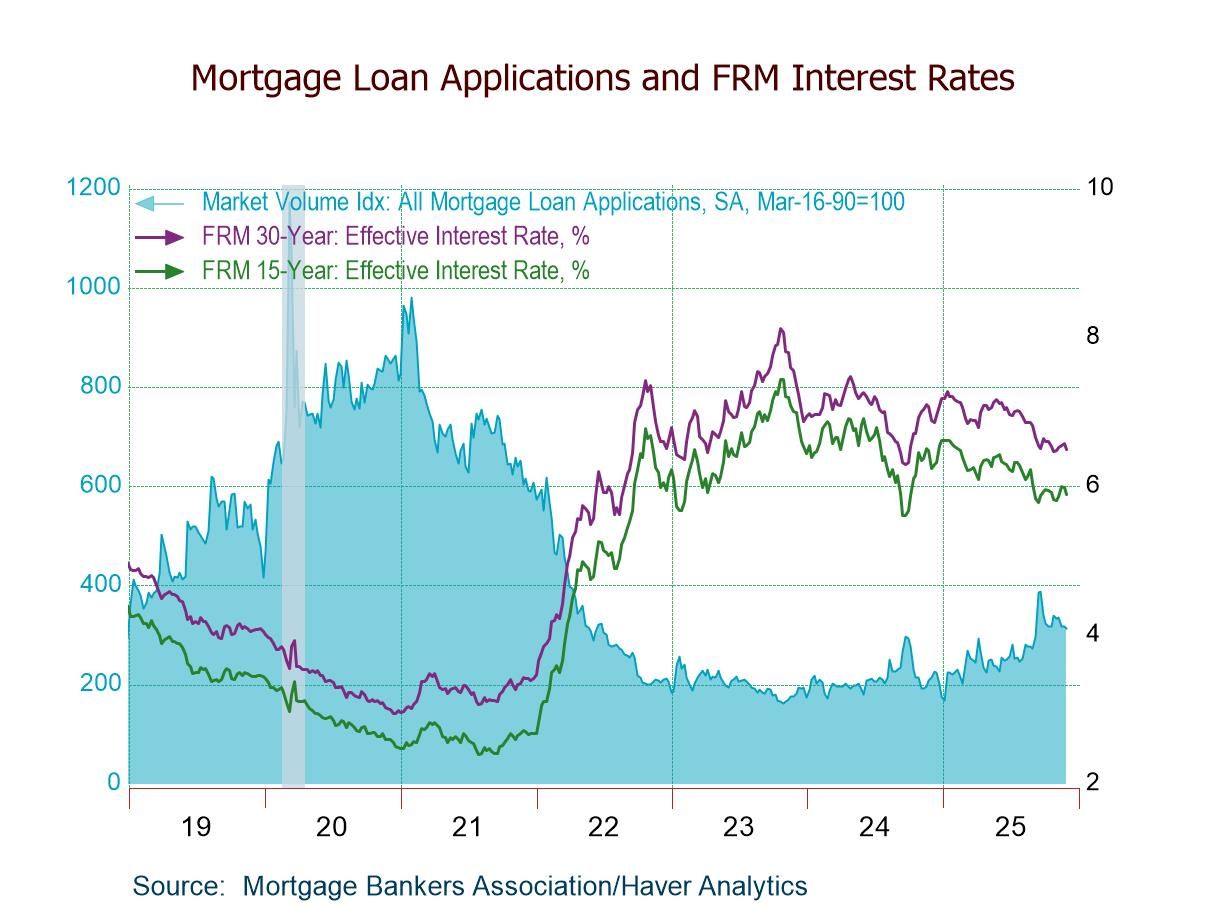 Global| Dec 20 2006
Global| Dec 20 2006Mortgage Applications Reversed Gain
by:Tom Moeller
|in:Economy in Brief
Summary
In a complete reversal of the prior week's gain, the total number of mortgage applications fell 10.2% last week after the 11.5% jump during the prior period, according to the Mortgage Bankers Association. Purchase applications fell [...]

In a complete reversal of the prior week's gain, the total number of mortgage applications fell 10.2% last week after the 11.5% jump during the prior period, according to the Mortgage Bankers Association.
Purchase applications fell 5.9% following an 8.7% rise during the prior week. Notwithstanding the decline, purchase applications remained in December 9.0% above the November average which rose 6.4% from the October level.
During the last ten years there has been a 58% correlation between the y/y change in purchase applications and the change in new plus existing single family home sales.
Applications to refinance slid 14.6% after two weeks of double digit increase. In December applications to refinance are 9.8% higher than in November.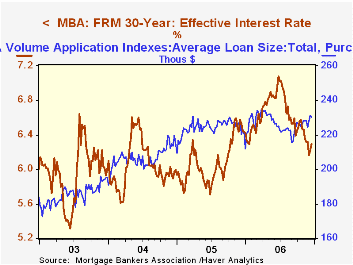
The effective interest rate on a conventional 30-year mortgage increased again w/w to 6.29% but the 6.22% average so far in December is down versus 6.36% during November. The peak for 30 year financing was 7.08% late in June. Rates for 15-year financing also increased to 6.07% but has averaged 5.99% this month versus 6.13% during November. Interest rates on 15 and 30 year mortgages are closely correlated (>90%) with the rate on 10 year Treasury securities.
During the last ten years there has been a (negative) 79% correlation between the level of applications for purchase and the effective interest rate on a 30-year mortgage.
The Mortgage Bankers Association surveys between 20 to 35 of the top lenders in the U.S. housing industry to derive its refinance, purchase and market indexes. The weekly survey covers roughly 50% of all U.S. residential mortgage applications processed each week by mortgage banks, commercial banks and thrifts. Visit the Mortgage Bankers Association site here.
Economic Inequality in the United States from the Federal Reserve Bank of San Francisco can be found here.
| MBA Mortgage Applications (3/16/90=100) | 12/15/06 | 12/08/06 | Y/Y | 2005 | 2004 | 2003 |
|---|---|---|---|---|---|---|
| Total Market Index | 647.6 | 721.2 | 8.9% | 708.6 | 735.1 | 1,067.9 |
| Purchase | 436.5 | 463.8 | -3.7% | 470.9 | 454.5 | 395.1 |
| Refinancing | 1,968.8 | 2,304.4 | 38.8% | 2,092.3 | 2,366.8 | 4,981.8 |
by Carol Stone December 20, 2006
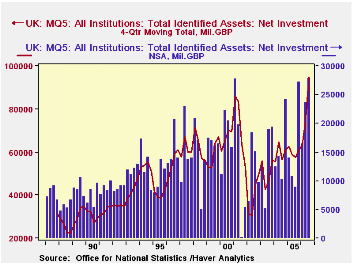
UK institutional investors added a record amount to their asset portfolios in Q3, according to the "First Release" of the widely followed "MQ5" report, which was issued this morning by the Office of National Statistics. Insurance companies, pension funds and trusts (mutual funds) acquired a net of £27.8 billion in UK and overseas securities, cash, and real estate and other assets, compared with £23.6 billion in Q2 and a previous record of £27.7 billion in Q1 2001. Further, the sum of the first three quarters of 2006 is £67.7 billion, just £1.8 billion shy of the largest investment amount in any previous YEAR, which was £69.5 billion in 2000.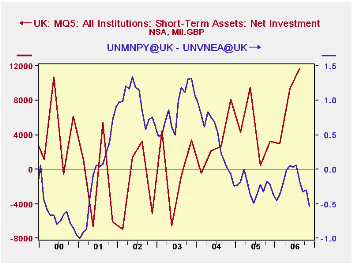
Investment patterns have been quite interesting this year as well. In both Q2 and Q3 the firms have concentrated on additions to short-term holdings. See in the table below that such "cash and equivalents" are a large proportion of net investment, indeed, about 42% in Q3. In Q2 they were 40% of the total. This looks at a glance to reflect the negative yield curve in the UK -- and elsewhere, for that matter. In the second graph, we show net investment in short-term assets against the yield curve, measured as the spread between the 10-year nominal par yield on gilts and the 1-month sterling inter-bank rate. There appears to be a rough negative relationship, and indeed, why would investors put their money out long when short instruments pay more?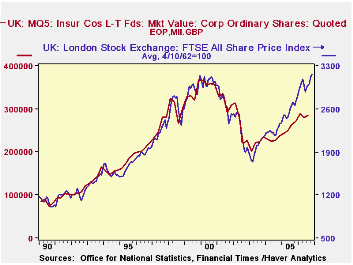
A second development of interest is the net liquidations of company shares, which are evident in our table. These groups of institutions have been net sellers of shares continuously since the spring of 2003, and off-and-on since 1999. It is important to notice here that these figures are the net of acquisitions and what in the UK are known as "realisations". They are NOT net changes in market value. In fact, the latter have been positive, as seen in the third graph, which also shows the trend in stock prices. The market value of stock holdings has continued to rise, even as this important UK investor group has been selling. It's an intriguing situation.
| UK: MQ5 Net Investment, £ Millions |
Q3 2006 | Q2 2006 | Q3 2005 | Quarterly Averages|||
|---|---|---|---|---|---|---|
| 2005 | 2004 | 2003 | ||||
| Total Identified Assets | 27,776 | 23,552 | 8,898 | 15,183 | 15,250 | 14,048 |
| Short-Term | 11,699 | 9,395 | 439 | 4,357 | 3,103 | 157 |
| British Govt Securities | 6,035 | 4,804 | 3,042 | 2,450 | 4,150 | 4,974 |
| UK Company Shares | -8,203 | -8,460 | -6,044 | -5,507 | -5,209 | -1,293 |
| Other UK Company Securities | 3,178 | 5,517 | 3,111 | 3,545 | 5,126 | 6,445 |
| Overseas Company Shares | 3,021 | -1,832 | 3,253 | 3,289 | 3,594 | 924 |
| Other Overseas Company Securities | 5,530 | 6,671 | -495 | 1,891 | 2,435 | 1,742 |
| Overseas Govt Securities | 2,266 | 2,219 | -596 | 89 | -1,011 | -859 |
Tom Moeller
AuthorMore in Author Profile »Prior to joining Haver Analytics in 2000, Mr. Moeller worked as the Economist at Chancellor Capital Management from 1985 to 1999. There, he developed comprehensive economic forecasts and interpreted economic data for equity and fixed income portfolio managers. Also at Chancellor, Mr. Moeller worked as an equity analyst and was responsible for researching and rating companies in the economically sensitive automobile and housing industries for investment in Chancellor’s equity portfolio. Prior to joining Chancellor, Mr. Moeller was an Economist at Citibank from 1979 to 1984. He also analyzed pricing behavior in the metals industry for the Council on Wage and Price Stability in Washington, D.C. In 1999, Mr. Moeller received the award for most accurate forecast from the Forecasters' Club of New York. From 1990 to 1992 he was President of the New York Association for Business Economists. Mr. Moeller earned an M.B.A. in Finance from Fordham University, where he graduated in 1987. He holds a Bachelor of Arts in Economics from George Washington University.





